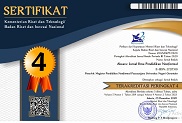Visual Expression of Insight Through Nature
Abstract
Nature inspires many artists, and is explored through visual expression using various media and techniques. Various streams that visualize this include realism or naturalism. These visual expressions can represent and record nature. Visual expressions that are conveyed in an abstract form that can provide a natural atmosphere by bringing calm, comfort, have not been explored by many artists both from within and outside the country. This creation aims to find out how to convey a calm situation through art works to art appreciators. The benefit of this creation for the development of society is that it can create a "reflective effect" for the public, both visually and spiritually/psychically. This art creation method uses qualitative descriptive and exploratory methods. The process of collecting data through library research, and searching on the internet. The results of the art creation process are 4 works that carry the theme of inner peace using oil paint on canvas measuring 60 x 60 cm. The composition of the 4 works is dominated by center and asymmetrical compositions. Coloring is dominated by using cheerful and contrasting colors, namely blue, yellow, green, white and a mixture of these colors. The conclusion of this creation is that the appreciator can capture natural objects that are visualized in each work.
Keywords
Full Text:
PDFReferences
Abd Rahman, Norfarain, Abd Rasid Ismail, and Ruslan Abdul Rahim. 2020. “Revolutions
of Mural Painting.†International Journal of Academic Research in Business and
Social Sciences 10(10):1195-1200. doi: 10.6007/ijarbss/v10-i10/8279.
Aceto, Maurizio, Elisa Calà , Simone Cantamessa, Angelo Agostino, Gaia Fenoglio,
Valerio Capra, and Giulia Brun. 2019. “From the Pyrenees to the Alps: Evidence of
the Use of Aerinite on XII Century Fresco Paintings at Novalesa Abbey (Piemonte).â€
Journal of Archaeological Science: Reports 25(January):15-24. doi:
1016/j.jasrep.2019.03.036.
Alashari, Duaa, and Johor Bahru. n.d. “THE SIGNIFICANCE OF FELDMAN
METHOD IN ART CRITICISM AND ART EDUCATION.†International Journal
of Psychosocial Rehabilitation 25:2021. Alya, Shopia Himatul. 2021. “Lukisan Pemandangan: Teknik Spon Dalam Karya Seni
Lukis Jelekong.†Aksara: Jurnal Ilmu Pendidikan Nonformal 7(1):103. doi:
37905/aksara.7.1.103-110.2021.
Arifian, A. 2017. Sejarah Dunia Abad Pertengahan 500-1400 M. Yogyakarta: PT Anak
Hebat Indonesia.
Balik, Gökhan, and Deniz Balık Lökçe. 2019. “On the Relationship of Landscape and
Painting.†AM Journal of Art and Media Studies (19):29-44. doi:
25038/am.v0i19.305.
Dewi. 2020. “Lukisan Dinding Gua Lascaux.†Rian Gambar.
Earnshaw, Rae A. 2017. Art, Design and Technology : Collaboration and
Implementation. United Kingdom: Springer International Publishing AG.
Happonen, Ari. 2015. “Art-Technology Collaboration and Motivation Sources in
Technologically Supported Artwork Buildup Project.†ScienceDirect 78:407-14.
Hautala, Johanna, and Oliver Ibert. 2018. “Creativity in Arts and Sciences: Collective
Processes from a Spatial Perspective.†Environment and Planning A 50(8):1688-96.
doi: 10.1177/0308518X18786967.
Iswandi, Heri. 2016. “Seni Mural Sebagai Unsur Politik Dalam Kehidupan Sosial.â€
Besaung: Jurnal Seni Desain Dan Budaya 1(1):9-14.
Kleiner, Fred S. 2014. Gardner's Art Through The Ages: A Concisw Western History.
Third Edit. edited by S. A. Poore. Boston: Wadsworth, Cengage Learning.
Marder, Lisa. 2019. “Ways of Defining Art.†ThoughtCo.
McKay, Loraine, and Viviana Sappa. 2020. “Harnessing Creativity through Arts-Based
Research to Support Teachers' Identity Development.†Journal of Adult and
Continuing Education 26(1):25-42. doi: 10.1177/1477971419841068.
Pálsdóttir, Anna MarÃa, Ulrika K. Stigsdotter, Dennis Persson, Petra Thorpert, and Patrik
Grahn. 2018. “The Qualities of Natural Environments That Support the
Rehabilitation Process of Individuals with Stress-Related Mental Disorder in
Nature-Based Rehabilitation.†Urban Forestry & Urban Greening 29:312-21. doi:
1016/J.UFUG.2017.11.016.
Pangestika, Galih. 2017. “Pesona Alam Sebagai Ide Penciptaan Karya Seni Lukis -
Digilib.†UPT Perpustakaan ISI Yogyakarta. Retrieved March 2, 2022
(http://digilib.isi.ac.id/2211/).
Pramana, Gede Indra, and Azhar Irfansyah. 2019. “Street Art Sebagai Komunikasi
Politik: Seni, Protes, Dan Memori Politik.†Jurnal Ilmiah Widya Sosiopolitika
(2):98. doi: 10.24843/jiwsp.2019.v01.i02.p04.
Rachmat, Gerry, and Riana Safitri. n.d. “Mural, Menggambar Manual Pada Dinding,
Sebagai Pembentukan Suasana Interior Cafe.†110-16.
Reading, Christina. 2015. “Re-Presenting Melancholy : Figurative Art and Feminism
Christina Reading A Thesis Submitted in Partial Fulfilment of the Requirements of
the University of Brighton for the Degree of Doctorate in Fine Art April 2015 The
University of Brighton in Collaborat.†The University of Brighton in collaboration
with the University for the Creative Arts.
Santosa, Janette Kiara Zerlinda; Pandanwangi, Ariesa. 2020. “SENI DAN TEKNOLOGI:
MANFAAT DAN FUNGSI DALAM KEHIDUPAN MANUSIA.†Prosiding ISBI.
Sonntag-Öström, Elisabet, Therese Stenlund, Maria Nordin, Ylva Lundell, Christina
Ahlgren, Anncristine Fjellman-Wiklund, Lisbeth Slunga Järvholm, and Ann Dolling. 2015. “‘Nature's Effect on My Mind' - Patients' Qualitative Experiences
of a Forest-Based Rehabilitation Programme.†Urban Forestry & Urban Greening
(3):607-14. doi: 10.1016/J.UFUG.2015.06.002.
Steele, Cassie. 2020. “Examining the Realtionship Between Nature and Art.â€
CulturePartnership.Eu. Retrieved March 2, 2022
(https://www.culturepartnership.eu/en/article/nature-and-art).
Sugiharto, Farid Dwi Bagus, and Satriana Didiek Isnanta. 2019. “REFLEKSI DIRI
TERHADAP HUBUNGAN MANUSIA DAN ALAM SEBAGAI SUMBER
INSPIRASI PENCIPTAAN KARYA SENI RUPA EKSPERIMENTAL.â€
Brikolase : Jurnal Kajian Teori, Praktik Dan Wacana Seni Budaya Rupa 10(2):134.
doi: 10.33153/BRI.V10I2.2327.
Sukirno. 2009. “Fenomena Alam Sebagai Sumber Inspirasi Penciptaan Karya Seni
Lukis.†Brikolase : Jurnal Kajian Teori, Praktik Dan Wacana Seni Budaya Rupa
(2). doi: 10.33153/BRI.V1I2.255.
Wijaya, Kerine Claudya, Ariesa Pandanwangi, and Belinda Sukapura Dewi. 2021.
“Mirror As Inspiration In The Creation Of Artworks.†Aksara: Jurnal Ilmu
Pendidikan Nonformal 7(3):1009. doi: 10.37905/aksara.7.3.1009-1016.2021.
Wolverton, Ben. 2016. “Why Nature Inspires Art.†Eaglenest. Retrieved March 2, 2022
(https://blog.eaglesnestoutfittersinc.com/why-nature-inspires-art/).
Yupardhi, Toddy Hendrawan, and I. Kadek Dwi Noorwatha. 2019. “Instagrammable
Interior : Studi Preferensi Tampilan Estetik Dan Kreatif Interior Tempat Kuliner
Untuk Generasi Milenial.†Pp. 46-55 in Seminar Nasional Sandyakala. Denpasar:
ISI Denpasar.
Zhang, Y., and L. Candy. 2006. “Investigating Collaboration in Art and Technology.â€
CoDesign 2(4):239-48. doi: 10.1080/15710880601008059.
DOI: http://dx.doi.org/10.37905/aksara.8.2.1163-1176.2022
Refbacks
- There are currently no refbacks.
Copyright (c) 2022 Aksara: Jurnal Ilmu Pendidikan Nonformal

This work is licensed under a Creative Commons Attribution-ShareAlike 4.0 International License.
Publisher:
Magister Pendidikan Nonformal Pascasarjana Universitas Negeri Gorontalo
Jl. Soedirman No. 06 Gorontalo 96128 e-mail: jurnalaksara@ung.ac.id
http://ejurnal.pps.ung.ac.id







